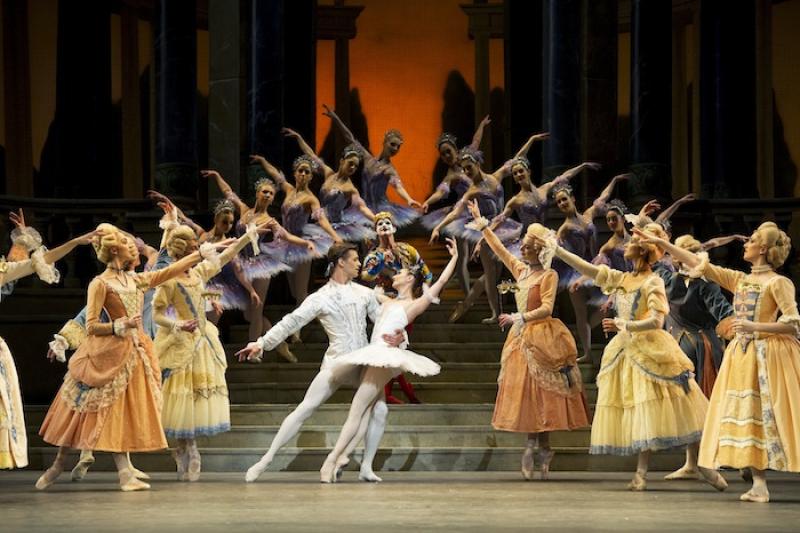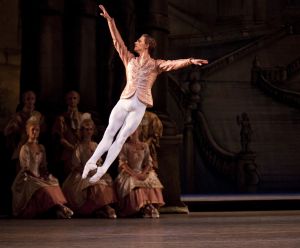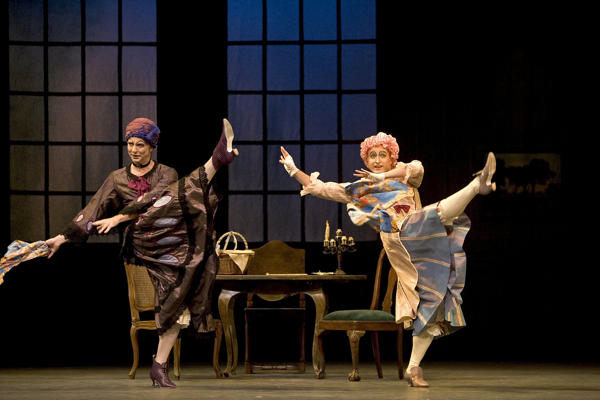Cinderella, Royal Ballet | reviews, news & interviews
Cinderella, Royal Ballet
Cinderella, Royal Ballet
Reviews of two casts in the Ashton classic - notably Alina Cojocaru and Sergei Polunin

No longer, it seems, need ballet's most transformable heroine languish by the seasonal fireside. It's true that you'll have to wait until Christmas to see the most visually striking Cinderella of all again - Ashley Page's fitfully ingenious Scottish Ballet version showcasing magical designs by Antony McDonald. But English National Ballet's Cinders is out and about this spring, and now Ashton's first full-length triumph returns with period glitter to Covent Garden.
Ashton's greatest gift to posterity here is the intricacy of the company numbers, weaving fairies and cavaliers, lilac-tutued allegories of the hours and 18th-century courtiers in a dazzling homage to the aristocrat of classical ballet, Petipa's Sleeping Beauty. And this is perhaps as it should be, for if Prokofiev's second full-length ballet score can't quite boast the range of Romeo and Juliet - the only equal to Tchaikovsky's unsurpassable masterpiece - it does serve entrenched Soviet conservatism with more divertissements. The one featuring foreign beauties pressing forward to fit the slipper has gone in Ashton's version, reducing the last act to a shorter running-time than the preceding interval - a shame, though the music perhaps isn't top-drawer Prokofiev - while the Act One variations of seasonal fairies in the Fairy Godmother's entourage is perhaps the least memorable quarter-hour of Ashton's choreography.
None of the fairies, not even Laura Morera's guiding spirit, made much of a mark here; the temporary star - as in the Scottish Ballet production - is the set, Toer van Schayk's painted flats sliding back as spring yields to summer, summer to autumn and - a glittering backdrop - autumn to winter. The tempi for languid Fairy Summer (Yuhui Choe) and precise Fairy Winter (Hikaru Kobayashi, making the most impact by virtue of the arm gestures) felt too slow, while conductor Pavel Sorokin didn't lift the livelier numbers enough - a disappointment after the spring and nuance of more natural Prokofievian Boris Gruzin.
That was a problem, too, for the pantomime-dame antics of stepsisters Wayne Sleep and Luke Heydon; more buoyancy in the pit would have given more energy to the dancers. Sleep is the squat sister, making a great deal out of reclining on her sister's uncomfortable breast, but also - working against Ashton's chararacterisations - the more dominant of the two. I've seen at least one half of this partnership work better with the consummate mime of Alastair Marriott.
The ball scene solves all problems. The sisters become implicated with two character cavaliers (Gary Avis and Michael Stojko, filling out the detail); the fairies get their own partners and trace more interesting patterns as part of the collective. Ashton makes Prokofiev's stack of court dances before the crucial meeting of Cinderella and her Prince pass in a flash. The truly virtuoso male role is that of the ubiquitous court jester, homage perhaps to the Sergeyev Swan Lake; Paul Kay made a charismatic impact here.
Rupert Pennefather's Prince shines in silver, a tall, handsome presence, though not fully suggestive of a young man lovestruck at first sight and not quite confident as yet in his leaping variation (maybe it was daunting to be perceived as taking the place of Cojocaru's regular and real-life partner, Johan Kobborg). Cojocaru, having had little to do but smile sweetly and mix pretty point-work with out-turned feet in her Act One dreaming, instantly conveys both the is-this-for-real? wonder and the perfect poise of Cinderella's star-struck arrival at the ball - a spellbinding moment framed by a frozen corps. As for the orchestra, it sounds best in the flat-out sonorities of the great waltz and the wide-spanning pas de deux. And, yes, we get both the pumpkin coach and the full drama of midnight, which Ismene Brown missed in the ENB version. Here, on a Saturday afternoon, children squealed with delight at the first and with terror at the second.
Grumble as I may have done about the last-act cuts and the unnecessary second interval - very unfashionable in the operatic world, where two-hour works can run continuously - the last 23 minutes certainly delivered all the goods. Musical-dramatic recaps were all succinctly presented, and Pennefather's sweetest triumph came on one knee, a moment of irresistible tenderness. In the pretty pictures of the apotheosis, the entire company, crowned by Cojocaru's poised radiance, reinforced the sense of time suspended. Old-fashioned indeed - but if the magic can still affect young and old alike, why tamper with it?
Ismene Brown reviews Sergei Polunin and Yuhui Choe:
 When a 20-year-old bursts onto the stage like a prince inheriting his kingdom, something special has happened. In just one, unfair, single appearance in a junior-cast matinee of Cinderella yesterday, Sergei Polunin made the Covent Garden audience see stars. It was perhaps a little hard on his Cinderella, Yuhui Choe, also debuting in her lead role, that she, an exquisite dancer as she is, was left in the tail of this blazing comet.
When a 20-year-old bursts onto the stage like a prince inheriting his kingdom, something special has happened. In just one, unfair, single appearance in a junior-cast matinee of Cinderella yesterday, Sergei Polunin made the Covent Garden audience see stars. It was perhaps a little hard on his Cinderella, Yuhui Choe, also debuting in her lead role, that she, an exquisite dancer as she is, was left in the tail of this blazing comet.
Polunin has been eyecatching from the moment he joined from the Royal Ballet School two years ago, mature far beyond his years, with the profile of a leader of men, and the frown of a seriously thoughtful artist. I missed his debut as Prince Florimund in The Sleeping Beauty this season (pictured by Johan Persson), but this Ashton prince in Cinderella is a true test of talent. In essentially just three sequences - leading his court ball, meeting and duetting with Cinderella, and finally matching her - a chap must leave an indelible mark. And Polunin leaves images that burn in the memory - the way he exploded onto the stage in Act 2 like a star who had delayed his audience long enough, the reverent delicacy with which he treated Choe, the amused politeness with which he fended off the ugly stepsisters, the height of his leaps, and maybe most of all, the turn of his head and that fierce profile - this all speaks of a major young male star in British ballet, and one whom I’d urge you all to book up in anything.
This season he has showed a prodigiously commanding range - a dark dramatic presence in The Judas Tree, a dangerously elegant Benvolio, a fastidiously aristocratic Florestan among others, not one dud among them. The Ukraine-Royal Ballet connection has produced some wonderful alchemy recently, with Kiev-trained Alina Cojocaru and Ivan Putrov preceding Polunin, and this boy looks set for the highest achievements.
 Choe certainly has the artistry to do the same, a butterfly lightness and extraordinary musicality that flows through her body, but she must learn to open her face more to the audience and show them Cinderella, dance louder than mezzo-piano con delicatezza, and take on that mystical extra glow of the ballerina. Yesterday she was fighting to be seen against the now brazen panto style of the two stepsisters (pictured by Bill Cooper), Alastair Marriott doing a fortissimo impression of Frances de la Tour, and Jonathan Howells starting sweetly as the “shy” sister but soon joining in the broad music-hall tone. Competing with them for come-to-the-Cabaret honours was the most 21st-century Jester I’ve seen yet, the lithe Fernando Montaño, made up to the nines and leering while he did his split jumps - not remotely fitting this cheap-looking Hallmark-cards production, but certainly provoking questions about the significance of Jesters in solitary Princes’ courts.
Choe certainly has the artistry to do the same, a butterfly lightness and extraordinary musicality that flows through her body, but she must learn to open her face more to the audience and show them Cinderella, dance louder than mezzo-piano con delicatezza, and take on that mystical extra glow of the ballerina. Yesterday she was fighting to be seen against the now brazen panto style of the two stepsisters (pictured by Bill Cooper), Alastair Marriott doing a fortissimo impression of Frances de la Tour, and Jonathan Howells starting sweetly as the “shy” sister but soon joining in the broad music-hall tone. Competing with them for come-to-the-Cabaret honours was the most 21st-century Jester I’ve seen yet, the lithe Fernando Montaño, made up to the nines and leering while he did his split jumps - not remotely fitting this cheap-looking Hallmark-cards production, but certainly provoking questions about the significance of Jesters in solitary Princes’ courts.
Francesca Filpi was a grave and lovely Fairy Godmother, making a tasteful gem of her one solo; of the seasons Elizabeth Harrod was a quick, effervescent Spring; Paul Kay and Gary Avis gave (as ever) excellent value as the Little and Large courtiers, José Martin’s Dancing Master was attractive, and the four Prince’s Friends were sharp as knives in their quartet. But it’s Polunin on whom the golden promises must shower; a deeply exciting prospect.
- Cinderella runs at the Royal Opera House until 5 June
- Read more Royal Ballet reviews
Explore topics
Share this article
Add comment
The future of Arts Journalism
You can stop theartsdesk.com closing!
We urgently need financing to survive. Our fundraising drive has thus far raised £49,000 but we need to reach £100,000 or we will be forced to close. Please contribute here: https://gofund.me/c3f6033d
And if you can forward this information to anyone who might assist, we’d be grateful.

Subscribe to theartsdesk.com
Thank you for continuing to read our work on theartsdesk.com. For unlimited access to every article in its entirety, including our archive of more than 15,000 pieces, we're asking for £5 per month or £40 per year. We feel it's a very good deal, and hope you do too.
To take a subscription now simply click here.
And if you're looking for that extra gift for a friend or family member, why not treat them to a theartsdesk.com gift subscription?
more Dance
 'We are bowled over!' Thank you for your messages of love and support
Much-appreciated words of commendation from readers and the cultural community
'We are bowled over!' Thank you for your messages of love and support
Much-appreciated words of commendation from readers and the cultural community
 R:Evolution, English National Ballet, Sadler's Wells review - a vibrant survey of ballet in four acts
ENB set the bar high with this mixed bill, but they meet its challenges thrillingly
R:Evolution, English National Ballet, Sadler's Wells review - a vibrant survey of ballet in four acts
ENB set the bar high with this mixed bill, but they meet its challenges thrillingly
 Like Water for Chocolate, Royal Ballet review - splendid dancing and sets, but there's too much plot
Christopher Wheeldon's version looks great but is too muddling to connect with fully
Like Water for Chocolate, Royal Ballet review - splendid dancing and sets, but there's too much plot
Christopher Wheeldon's version looks great but is too muddling to connect with fully
 iD-Reloaded, Cirque Éloize, Marlowe Theatre, Canterbury review - attitude, energy and invention
A riotous blend of urban dance music, hip hop and contemporary circus
iD-Reloaded, Cirque Éloize, Marlowe Theatre, Canterbury review - attitude, energy and invention
A riotous blend of urban dance music, hip hop and contemporary circus
 How to be a Dancer in 72,000 Easy Lessons, Teaċ Daṁsa review - a riveting account of a life in dance
Michael Keegan-Dolan's unique hybrid of physical theatre and comic monologue
How to be a Dancer in 72,000 Easy Lessons, Teaċ Daṁsa review - a riveting account of a life in dance
Michael Keegan-Dolan's unique hybrid of physical theatre and comic monologue
 A Single Man, Linbury Theatre review - an anatomy of melancholy, with breaks in the clouds
Ed Watson and Jonathan Goddard are extraordinary in Jonathan Watkins' dance theatre adaptation of Isherwood's novel
A Single Man, Linbury Theatre review - an anatomy of melancholy, with breaks in the clouds
Ed Watson and Jonathan Goddard are extraordinary in Jonathan Watkins' dance theatre adaptation of Isherwood's novel
 Peaky Blinders: The Redemption of Thomas Shelby, Rambert, Sadler's Wells review - exciting dancing, if you can see it
Six TV series reduced to 100 minutes' dance time doesn't quite compute
Peaky Blinders: The Redemption of Thomas Shelby, Rambert, Sadler's Wells review - exciting dancing, if you can see it
Six TV series reduced to 100 minutes' dance time doesn't quite compute
 Giselle, National Ballet of Japan review - return of a classic, refreshed and impeccably danced
First visit by Miyako Yoshida's company leaves you wanting more
Giselle, National Ballet of Japan review - return of a classic, refreshed and impeccably danced
First visit by Miyako Yoshida's company leaves you wanting more
 Quadrophenia, Sadler's Wells review - missed opportunity to give new stage life to a Who classic
The brilliant cast need a tighter score and a stronger narrative
Quadrophenia, Sadler's Wells review - missed opportunity to give new stage life to a Who classic
The brilliant cast need a tighter score and a stronger narrative
 The Midnight Bell, Sadler's Wells review - a first reprise for one of Matthew Bourne's most compelling shows to date
The after-hours lives of the sad and lonely are drawn with compassion, originality and skill
The Midnight Bell, Sadler's Wells review - a first reprise for one of Matthew Bourne's most compelling shows to date
The after-hours lives of the sad and lonely are drawn with compassion, originality and skill
 Ballet to Broadway: Wheeldon Works, Royal Ballet review - the impressive range and reach of Christopher Wheeldon's craft
The title says it: as dancemaker, as creative magnet, the man clearly works his socks off
Ballet to Broadway: Wheeldon Works, Royal Ballet review - the impressive range and reach of Christopher Wheeldon's craft
The title says it: as dancemaker, as creative magnet, the man clearly works his socks off
 The Forsythe Programme, English National Ballet review - brains, beauty and bravura
Once again the veteran choreographer and maverick William Forsythe raises ENB's game
The Forsythe Programme, English National Ballet review - brains, beauty and bravura
Once again the veteran choreographer and maverick William Forsythe raises ENB's game

Comments
...
...
...
...
...
...
...
...